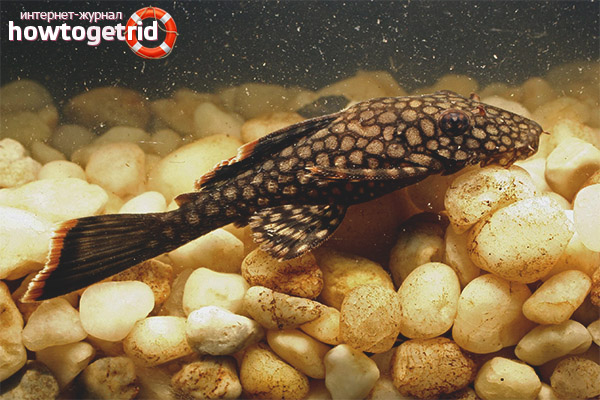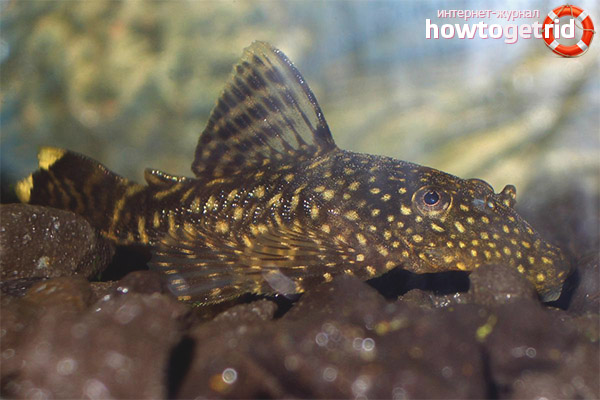The content of the article
Common Antcistruses or Ancistrus dolichopterus, also called sucker catfish, are actually from South America and are found in the Amazon. They live in the waters of large rivers and the most diverse swamps. The most common among them are representatives of the common ancytrus. Antiscistruses were imported into the USSR countries in the mid-70s of the 20th century.
Description
These fish are distinguished by an elongated, flattened body, whose length is from 10 to 14 cm, sometimes they are able to reach large sizes. It is covered with a strong carapace that protects this aquarium dweller from possible damage by external factors, which consists of bone plates. The elongated body is decorated with pectoral, abdominal, dorsal and small anal fatty fins. The head is large enough.
Males are larger and slimmer with peculiar leathery outgrowths in the head area resembling horns. The females are smaller and have no horns.
Neighborhood with other residents
These catfish get along well with other species of aquarium inhabitants. But they are not completely harmless. They can start chasing their neighbors, pestering them and even inflicting traumatic injuries.
Their cohabitation with slow species, for example, all the beloved gold ones, is contraindicated. Also, scaleless fishes are not suitable as cohabitants for antitruses, because there is a high risk of damage to the skin of the latter. Large and aggressive fish in a joint tank is also not the best option. Bloody fights can occur with them.
Life in an aquarium
Simple ancistruses or sticks - perfectly complement any freshwater aquariums. They feed, absorbing algae in huge volumes. Therefore, the tank must be provided with them in sufficient quantities.
However, they grow at home sometimes to quite impressive sizes of real river monsters. Aquarium catfish ancistruses remain, as a rule, small in size and infrequently reach 15 centimeters. For this reason, they are very appropriate as aquarium cleaners, unlike other representatives of their species.
Aquarium inhabitants of Antsistrus need a spacious tank. In addition, they are quite active, they need enough space to have a place for shelter and food. They spend almost all of their time in search of food, subsequent meals, and then again in search. For this reason, they secrete many products of their own vital activity, which leads to water pollution. For aquariums where Antsistruses live, it is necessary to equip them with powerful filters. The life expectancy of these fish is about 7 years, but, as a rule, they live much less.
In natural conditions, catfish anticistruses spend all the time hiding in any accessible shelters, snags and caves. In the tank where they are contained, it is important to create conditions as close to natural as possible. This can be done by installing ceramic pots, coconuts, large snags in the aquarium, which will become a convenient shelter for ancistruses if necessary.
When choosing filters, it is worth giving preference to internal ones. To enhance its effectiveness, you can use a simple washcloth, which will help increase the efficiency of water purification. But if possible, still the best option is to install an external canister filter.
As for lighting, it should in no case be bright.But in order for the aquarium to have good vegetation, which is simply necessary for the ancistruses, it needs to be lit. For this reason, it is worth arranging the lighting so that it appears and disappears periodically.
Antsistrus is a pretty unpretentious fish. They are able to adapt to any water parameters. The main thing is that it be clean and saturated with oxygen. Optimum conditions of detention: at a temperature of 22 to 28 degrees, acidity - from 6 to 7.5 and hardness up to 20 dH.
The arrangement of the soil consists in the fact that it consisted of sand with the addition of fine gravel. Its layer should be about 4 cm.
Nutrition

Antsistrusy love to eat and do it all the time. They need a lot of food. Their diet consists of plant foods, spirulina-shaped food in pill form is perfect. This option does not get soggy in water for a long time, and has an aroma that is attractive to ancistruses. You can supplement their food with vegetables, which will make the diet of these fish more diverse. As a top dressing, you can use zucchini, cucumbers and watercress.
Important! Remove leftover food from the tank in a timely manner to keep the water clean.
If catfish of ancistruses have a desire to breed, then it is necessary to introduce frozen food into the diet. As a live top dressing, you can use coronet and bloodworms. These are the only goodies that will suit this type for sure. It is important that the feed, which, as a rule, sink to the bottom, be freely available. Otherwise, they may simply not be noticed by ancistruses.
To catfish have the opportunity to take refuge for a while, digesting food, it is necessary to use driftwood. In addition, representatives of this species receive enzymes for digesting food, scraping pieces from a tree. If there is such a decor in the aquarium, they will always have good health and feel comfortable. Ideally, the bottom of the tank should contain several snags.
Breeding
Common Antcistruses breed well in captivity. If the tank is properly equipped, then they will not need additional assistance. It is important that there are more women than males, especially if the tank is small. In another situation, males may show aggression towards each other. After all, it is common for ancistruses to defend their own territory. In addition, they are able to eat the eggs of their competitors.
In preparation for the reproduction of ordinary ancistruses, it is necessary to determine the gender of the individuals contained in the aquarium. Male and female are distinguished by size. Also, male representatives have horns on their heads. The selected individuals are placed in a separate aquarium with suitable water parameters, this will contribute to spawning. In principle, they can engage in reproduction under any conditions, but suitable ones will make this process more efficient.
When the males are ready for breeding, they begin to arrange shelter, cleaning and protecting it. When a suitable place is ready, males begin to attract ladies with the help of tail punches. Having examined the selected shelter, the females lay eggs inside it. The eggs of Antsistrus are large, bright orange, hanging in clusters.
After the spawning of the females, the male is engaged in insemination of eggs, after which it drives away the future mother and is involved in the protection of future babies. Therefore, after the female has laid eggs, she is deposited in another tank.
Ripening of eggs lasts from a week to 10 days. Then fry appear. The males are engaged in their protection until the kids begin to swim. As soon as they swam, the parent needs to be resettled.
During the first days, fry are fed with ciliates and spirulina.After some more time, shrimp and vegetable feed are added to the diet, which feed on adult individuals of Antsistrus catfish.
Somik Antsistrus is quite spectacular and very unpretentious to the content in the home aquarium fish. It is for this reason that they are so popular today among beginner aquarists. In addition, Antsistrus is a natural “cleaner” of the reservoir, which makes life easier for its owner. Among other things, they are also wonderful neighbors for their relatives.
Nutrition of ancistrus is quite simple and affordable for any owner. However, they do require that they be kept in a clean and adequate size aquarium. For all the unpretentiousness of this species, it is necessary to provide their accommodation with minimal care and high-quality filtration.
Video: catfish-ancistruses (sticky)











Submit